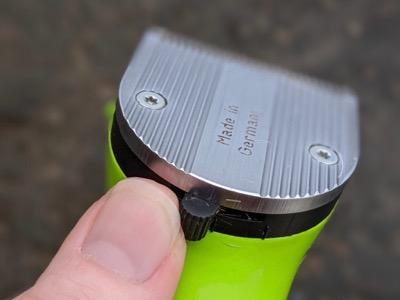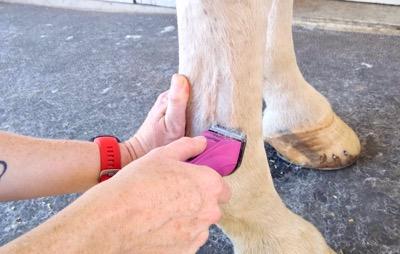Tips for Clipping Faces, Legs, and Other Tricky Parts of Your Horse
Clipping season has arrived, time to spic-n-span your horse. But only if that’s your jam.
Pro tips before you even bust out the clippers:
- Start with a clean horse and clean, sharp blades. I’m certain that I have typed these words more than any other words in the history of typing things. Dirty horses and dull or dirty blades contribute massive discomfort for your horse! Pulling and tugging, lines and uneveness, and general frustration result. This can be amplified as you work on the sensitive areas of your horse, like his face.
- I will never suggest spraying a horse in the face with water during a bath as you work on prepping him for clipping. This is the time for patience, sponges, and washcloths. Just make sure it’s all clean before you go.
- Learn more about how to prep your horse for awesome clipping read this amazing article.
Use the appropriate clippers and blade for the job.
- You definitely don’t want to use the large shear-type clippers on your horse’s face. You also don’t want to use a body clipper that has a wide blade. Stick to either a smaller lightweight trimmer or go for a body clipper that has a regular-sized blade.
- You might also want to leave a little extra hair on your horse. A #8.5 is preferred to a number 10 or a number 15 blade as it leaves a bit more hair. If you are using trimmers with a 5-in-1 blade that goes from a #9 to a #40, make sure the adjustable blade is set to #9. You will know immediately if it’s not, as all of the hair is gone. Whoopsie!

This handy little knob controls the adjustable blade of this Arco trimmer.
- You want to think about how your horse reacts to cords if he’s sensitive to chords in the first place. Cordless trimmers or clippers are ideal here. But, you have to use what you have or can borrow!
- For more details on clippers versus trimmers, this peachy article has you covered.
This is NOT the time to ask your horse to get over fears about cords and clippers.
- The time to train your horse for clipper sensitivity is months before you actually need to use them. I prefer to use a baby steps method of positive reinforcement. Let him get used to clippers in small steps!
- This will allow your horse, over time, to realize that being around the clippers, having them touch him, turning them on, and then eventually clipping his hair can become a positive experience.
- If you force him to be clipped he will always remember that. If you instead, create situations clippers equal praise and reward, he will also remember that. And, he will trust you more.
Use your spare hand to cover his eyes, ears, and nose as you work. Be safe around his legs, too!
- Use your spare hand to cover any areas that you don’t want your clipper blade jamming into. This might be something as accidental as taking off a little bit of the forelock but it could also be something like poking him in the eye. This sometimes happens because we are human and mess up, it also happens when horses move and act like horses. Either way, that’s a Vet bill to avoid.
- Your safety is paramount when you’re working around his legs. This is especially true around his elbows, in between the hind legs, and the lower legs. Keep one hand on your horse to feel him start to shift under you before he steps into you. This also provides a physical barrier for your horse so he knows to not to move into you. Please keep both of your feet on the ground and avoid kneeling. You can then quickly step out of the way should he shift towards you.
- If you were at all uncertain about how your horse will react in any area, please get a friend to help you. At the bare minimum, just having somebody who’s had monitoring his body language and perhaps entertaining him helps. Be sure both of you are on the same side!

Use your free hand to create a barrier. And if you accidentally zip off the forelock, it will grow back.
Tips for clipping your horse’s face.
- Only clip what is absolutely necessary. Some horses wear a grazing muzzle or cribbing strap. You might want to leave hair where the grazing muzzle or strap touches your horse. If the weather is particularly bad, consider leaving most of the face. Creating a half-face is one option. This loosely follows the line of his bridle. Everything in front of his cheek pieces would remain long
- Consider how a clipped face will interact with your horse’s tack. With some horses, the winter coat will actually get tangled in buckles and leather straps of a bridle. Other horses need that extra cushion of hair to prevent rubs. You’re going to have to experiment to see what works best on your horse.
- Turn your clipper blades so they are pointing away from eyes as you clip around that area. It’s absolutely fine to clip with the hair growth in that area.
- Don’t clip off any whiskers, eyebrows, or lashes. These are sensory organs, called vibrissae that help your horse navigate his world. Vibrissae signal your horse about what’s located in places they can’t see. Obviously, they need that these guys to find their favorite thing on the planet – food.

I’ve covered the eye and the eyebrow hairs above it.
Tips for clipping your horse’s lower legs.
- Pick up the lower leg so that the tendons get really soft and it’s easy to run your clippers up and down them. You want to face the front of your horse. Hold your horse’s hoof in one hand and use your other hand to run up the back of the leg without interference.
- But what about the spaces in between the tendons? When your horse’s hoof is on the ground, place your thumb on the skin next to the tendons and just slide it to the side. This is another instance of when you might like to trimmers to reach into that area.
- Blending the legs is an art form! If you are keeping the lower leg long but the upper leg will be clipped, consider blending. Turn the clippers upside down you create a blended look. This takes a bit of practice, and start on the upper leg. Rake, comb, and gently use your clippers to achieve a seamless transition between clipped and unclipped. If this blending technique is new to you, definitely start well above the knees and hocks. If you make some egregious error, which doesn’t matter, you have room to move down.
- What to do if the hair on the lower legs is very dense. Dense hair, like the hair surrounding knees and hocks, can be quite difficult to clip away. It helps to only use a tiny bit of your clipper blade, like the edge, instead of the whole width, to work in that area.

Push and slide that skin around!
Tips for clipping your horse’s skin folds and elbows.
- This is where having a friend is very helpful! Your helper can stretch the front leg forward to give you room to access the folds around your horse’s elbow. Slide the skin side to side to get your clipper blades into all of those nooks and crannies. I called this the push and slide method of clipping, and it works in other areas too, such as the throat latch and depressed areas above the eyes.
- You may have seen a technique where your lower leg calf muscle is stretching the front leg out so you can reach the elbow by yourself. I don’t recommend this technique, it throws you off balance. One false move and you are in a giant stinky pickle. Have a friend help you!
Tips for clipping around the girth area
- This is an area where, depending on the horse, one of two things can happen. The longer hairs can interfere with the tack and can get pulled, tugged, and stretched as your horse moves. There’s also the instance where the long hair under the girth will act like hairy sandpaper and rub sores.
- If you’re worried about rubs or you start to see some irritation there, use an anti-friction stick under the girth area to help things slide around without rubbing. This sometimes leaves a mess over time. Some horses do better with the girth area clipped, with or without some anti-friction stick.

These friction-blocking sticks are also great for blanket rubs. Use it before you see a bald spot!
More pro tips for clipping tricky areas.
- Use a safe stepstool while clipping faces. Even if you are tall, this work without some elevation is tiring on your arms and back.
- If your horse is used to clippers on the rest of his body, work on running the clippers around his face weeks before you actually clip. Make this a positive experience! It’s all fun and games until your horse realized the clippers are going to be on his face.
- Throw all the rules about “only clipping against the grain” out of the window! Attack cowlicks and tight spaces from all angles. You will need to push and slide the hair in all sorts of combinations here as you go along.
- When you are done, use grooming gloves or a cloth to wipe away any stray hairs. Adding some conditioning grooming oil with a cloth is a nice final touch, too.
- Don’t worry about it so much, it all grows back!

You can click these links if you want to shop for horse supplies easily. As an Amazon Associate, I earn from qualifying purchases, which are not a penny more for you. I couldn’t be more grateful for your support! You can also visit my Amazon storefront here: PEG storefront.
These lightweight trimmers are powerful and easy to hold.
These powerful trimmers have a 90 minute run time, and you can use them as you charge if needed!
This is my favorite clipper - It's great for body clipping, trace clipping, and trimming. Cordless for the win!
These wildly powerful shears are great for thick coats, and when I say thick, I mean it.
This new KM cordless clipper has constant power, no matter the haircoat, and rechargeable batteries that last 3 hours. It's quiet, and the wide blade makes clipping faster.
Thank you!






















